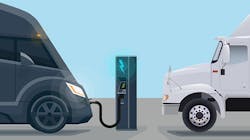I have been busting at the seams to tell you about NACFE’s involvement with a really cool program for high school juniors and seniors. But I was under strict orders not to say anything until the first phase of the competition was complete.
I am happy to say that has happened, and now I can talk about MathWorks Math Modeling (M3) Challenge, a program of the Society for Industrial and Applied Mathematics (SIAM).
This is an annual program to motivate students to study and pursue careers in applied math, computational science and technical computing. The way the program works is that students are given a problem and have 14 consecutive hours to come up with a solution.
This year the problem focused on electric trucks. More specifically the 760 teams of 3,500 students were asked to create a model to predict what percentage of semi-trucks will be electric in the next few years and decades. They were also asked to determine the number and locations of charging stations along major U.S. trucking routes that will be needed for an all-electric trucking industry. And they were asked to prioritize which routes should be developed with electric charging infrastructure first.
In 14 hours, teams are expected to develop mathematical models, a solutions paper of no more than 20 pages and an executive summary of their findings. They can also choose to write code as part of their work.
There will be two rounds of judging over the next several weeks and six finalist teams and three technical computing awardees will be selected to present their solutions to a panel of mathematical experts in New York City on April 27. Even though I am far from a mathematical expert, they are allowing me to join the judging panel to see their solutions.
There is so much to love about this project. First is that trucking was deemed worthy of being part of the program. Electric trucks have caught the attention of not just the trucking industry but a host of other folks in the general population. This is also a time where trucking got to share its story with young people. We had the chance to show the next generation of engineers and developers just how cool trucking is. I am hopeful that at least some of the students on these teams will decide that trucking is a pretty exciting place to work and will consider careers in our industry once they graduate from college.
I also like the idea of having all these fresh young unbiased minds looking into our industry. I assume they are coming into this competition with very little knowledge of trucks and trucking so they can approach the problem with completely open minds.
I am excited to see what the solutions that surface because of the M3 challenge. Solving the challenges of widespread deployment of electric trucks is going to take collaboration from a host of entities. Why not bring these eager young minds into the process early?
I will let you know how the teams do and what fact-based solutions they come up with. That is the other cool thing about the M3 Challenge. It is rooted in math and so the solutions will be logical and unbiased, with little hype. That is exactly what I think we need.
If you want to see the exact 2020 problem, click here. It might be an interesting exercise to put your own teams to work developing solutions. And to be fair, make sure you give them the same 14 hours these teenagers had. I am sure they will love the challenge!
About the Author

Michael Roeth
Executive Director
Michael Roeth is the executive director of the North American Council for Freight Efficiency. He serves on the second National Academy of Sciences Committee on Technologies and Approaches for Reducing the Fuel Consumption of Medium and Heavy-Duty Vehicles and has held various positions with Navistar and Behr/Cummins.
